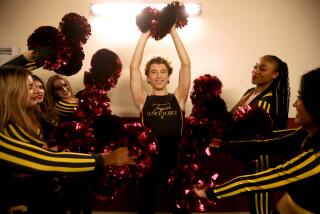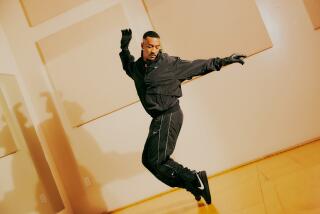Allen Decker troupe walks tall with âElationâ
Movement invention is the flaming sword that separates concert and commercial dance into wholly different worlds. You expect it in contemporary ballet and modern dance, but most jazz-dance and hip-hop merely give you new contexts and accompaniments for a familiar vocabulary -- as in the 11-part program by the hardworking Joseph Allen Decker Dance Company and guests at the Ivar Theatre on Saturday.
Indeed, the greatest movement invention of the evening came in Trey Knightâs spectacular and dangerous âElation,â which set out to prove that he, Nina McNeely and Michael Munez could do just about everything commercial dancers can do -- but on stilts. Flesh, flash and moves you never saw done this way: âElationâ had it all.
In the rest of the program, Decker and his associate choreographers -- Adam Parson, Murray Phillips and Terri Best -- reshuffled the same old same-old adroitly enough, pulling the expressive content of their pieces from the pop hits chosen as accompaniments.
Unfortunately, many of the music tracks didnât allow much time for development (Parsonâs expert âDolphineâ duet, for example), and the constant use of showpiece steps often proved counterproductive.
Phillipsâ new âRepressedâ duet made Meredith Kerr the victim of Danny Davalos. However, by giving him an appealing array of technically impressive partnering stunts, it implied, ruinously, that sexual harassment can be exciting and even desirable.
Since Deckerâs previously reviewed Nine Inch Nail tril- ogy, âTaboo,â fell prey to both Parsonâs and Phillipsâ weaknesses -- rushed expressivity and showpiece overkill -- it was brave for him to create âStorm,â an extended ensemble piece with no dramatic agenda. The result displayed everything he knew about steps and sequencing -- which was plenty -- without breaking through to anything original.
Just as Phillips in âRepressedâ never dared create movement raw and ugly enough to evoke the reality of sexual harassment, so Decker never found anything in his movement resources to evoke the chaotic force and fury of a storm. Prettifying these subjects while jacking up the bravura may make the dancers look good but doesnât take dance itself where it needs to be and where so many others have taken it.
Parsonâs own ensemble abstraction âElementsâ boasted intriguing spatial deployments and solid execution but needed a larger stage for maximum impact.
Bestâs âShadowsâ offered some of the eveningâs most dynamic group moves, but only the title conveyed her narrative concept: each ârealâ dancer coupled with a doppelganger.
By itself, the movement told another story, one show- ing same-sex relationships as deeper and far less turbulent than hetero partnerships -- and if thatâs not what she intended, the work needs drastic revision.
Phillipsâ aimless, witless group exercise âBitchâ and a promising work-in-progress by Christine Baltes completed the program.
More to Read
The biggest entertainment stories
Get our big stories about Hollywood, film, television, music, arts, culture and more right in your inbox as soon as they publish.
You may occasionally receive promotional content from the Los Angeles Times.










